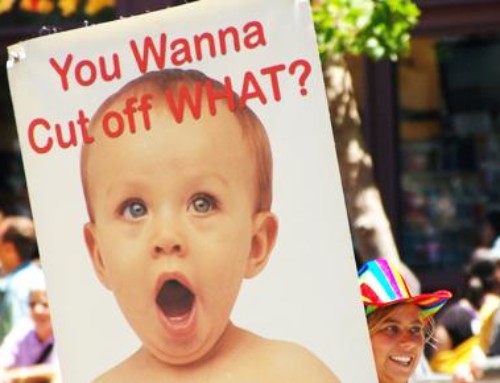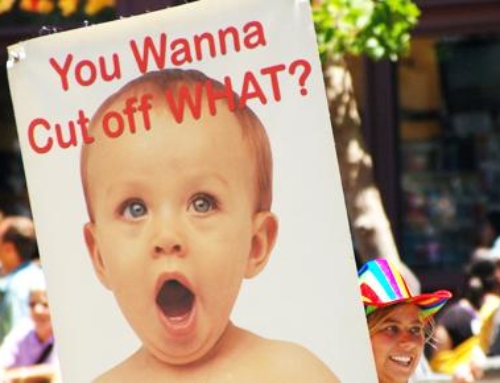A new study has been published in the Journal of the Royal Society of Medicine reporting a higher risk of Autism Spectrum Disorders (ASDs) in boys who have undergone infant circumcision
The Background
The big question that came to mind was how on earth these researchers even thought to study such a thing. What would the link look like? I had to admit my own ignorance on this particular link (which is embarrassing as I sit on the board for the Canadian Health and Human Rights Partnership which advocates against infant circumcision), but it turns out the logic is incredibly sound.
The premise begins with data dating back 70 years on the effect of painful and stressful surgeries in early childhood (not infancy) on later psychosocial outcomes (which I did know about). Although the original research focused on young children, we now know that young infants interpret noxious stimuli as adults and older children do; there are possible long-term effects of stressful and painful procedures on the later stress response, even if the infants cannot express their perceptions of the pain and stress[2][3]. Circumcision is a procedure that is known to be painful to many infants, even when some form of analgesia is used (as the pain relief is never 100%). Not only do some hospitals or doctors not use any pain relief when performing circumcision, but even the best pain relief (which is not complete and not always used as there are lesser forms of analgesia) has a complete failure rate of 6-8%[4][5][6]. This means the procedure is moderately painful for most boys but much more so for a significant minority. In terms of longer term effects with respect to circumcision per se, research has shown effects of infant circumcision on the pain response at 4-6 months of age[7].
This knowledge provides the first point of evidence for looking at a relationship between circumcision and later outcomes, but why ASDs? ASDs are a cluster of disorders and some of the features are alterations in pain perception and other noxious stimuli (either heightened or lowered) and usual reactions to stressful situations. Both of these are in line with animal and clinical research on long-term effects of stressful and painful procedures in infancy. Furthermore, a previous cross-cultural study found that with every 10% increase in a country’s neonatal circumcision rate, the prevalence of ASD increased by 2.01 per 1000 boys[8]. Additionally, in countries with higher rates of neonatal circumcision, the age of diagnosis for ASD s is significantly lower than for those countries with lower rates of neonatal circumcision[9][10].
The Data
The data was cohort data out of Denmark. Children who were born in Denmark between 1994 and 2003 were included for a total of 324,877 boys and 4986 ASD cases. As Denmark has socialized medicine, procedures conducted in hospital were noted as were any later diagnoses of ASDs. However, in 2003, Denmark no longer publicly subsidized infant circumcision and thus it was no longer tracked in the system. This is important and will be returned to in the discussion of strengths and limitations of the study.
The Findings
Across the entire sample, the risk of developing an ASD is 46% higher for circumcised boys than intact boys, and this is controlling for other birth and perinatal variables that were significant predictors (including birth factors which were independent predictors of ASDs, but that’s a discussion for another day), cultural background, birth year, and age. This was predominantly due to an increase in younger age diagnoses of ASDs (a diagnosis prior to age 5), for which the risk was 80% higher. There were no significant differences for later-onset ASDs.
There were also cultural differences in the risk of younger age ASDs, with Muslim boys (there were no separate data for Jewish individuals as the few orthodox Jewish circumcisions were all performed by one Rabbi, the rest with doctors) showing a 54% increased risk (still significant) but non-Muslim boys had over a 4-times increased risk of developing an infantile ASD. Notably, although there is an umbrella of disorders in ASDs, the largest risk factor was for the development of infantile autism, for which the overall risk was doubled for circumcised boys (combining all cultures).
Notably, various analyses were conducted to test the robustness of the findings and to ensure that other variables were not accounting for the findings. For example, the authors looked at the sisters of the boys who had been circumcised in order to determine if there was a genetic factor that was not identified when controlling for cultural background and other demographic variables; the findings were non-significant, demonstrating that the risk associated with circumcision was independent of any family variables. The number of analyses for robustness and the various statistical analyses conducted are so complete that there is little in the way of statistical issues that could be brought against the research. (I won’t go into details on the issue of stratification and using multiple time points, but suffice it to say, they know their statistical analyses and did them right.)
Limitations
Like all studies, this one also has its limitations, but luckily for them (and not-so-luckily for circumcision), their limitations err on the side of conservative estimates. The two largest limitations are to do with the data collection on circumcision. Because Denmark stopped paying for, and thus recording, infant circumcision in 2003 (unless medically indicated), there are no rates for the children born in the final years of this cohort and they are all considered to be “intact” unless there is specific information stating otherwise. This means that the data for the intact group contains children who are not, in fact, intact, and thus the risk errs on the side of conservative. One of the robust analyses confirms this robustness as the authors conducted the analyses with only those whose circumcision status was known and found that the overall risk of an ASD increased from 46% to 62% and thus we might expect the real risk to be higher than the 46%. The risk of a younger age diagnoses (0-4 years of age) remained high at an 83% increased risk (from 80%).
The second data collection limitation is that any child that was circumcised in a private doctor’s office or by a religious individual (and not a hospital) was not noted as being circumcised. Again, this puts boys who may be circumcised in the intact group, which serves to make the comparison more conservative than the reported results.
Conclusions
Like all research, it’s difficult to make conclusive remarks based on a single study, but what this very complete and large-scale study provides is more evidence that the early trauma of circumcision can increase the risk of ASDs. Will all boys suffer the same type of trauma? No. However, the failure rate of known analgesias, the failure of even the best analgesia to fully protect against pain, and the failure of some practitioners to even use any analgesia suggest that far more boys are experiencing a type of trauma that can have long lasting effects. (Interestingly, the differences by culture herein also suggest some type of cultural role in ASDs which is definitely in need of further exploration, but as I cannot speak to why the incidence is less in Muslim boys – and perhaps Jewish boys as well? – I cannot comment on what that cultural difference, especially at a genetic level, may be.)
Between the findings on heightened pain sensitivity associated with circumcision[7], the cross-cultural data linking ASDs to circumcision[8], and the within-country data showing us such a relationship herein[1], we have to stop and ask ourselves if the risks we’re taking on are really worth it, especially for routine infant circumcision (RIC). What is the benefit there? There is no religious “benefit” to RIC (religious benefits are a topic for another day) and it dates back to a time when circumcision was promoted in order to curb masturbation. Is that a practice worth upholding?
Perhaps what needs to be made very clear is that the risks spoken of herein are actually on par with most of the “health benefits” cited in favour of circumcision (and are not actually benefits given the cost to treat analyses based on base rates of disease in Western countries). When we consider the long-term effects of pain from RIC, we must ask ourselves, as a society, what we are doing to our young boys in the name of… what? Cleanliness? Nope, because an intact penis – when appropriately cared for – is clean. Health? Nope, because all of the “health benefits” have been thoroughly debunked when looking at rates of disease, age of onset of disease, other non-surgical solutions, and so on. Fitting in? Looking like dad? Are these really the best we’ve got? Wouldn’t they too change if we saw a cultural shift in circumcision?
I’ll end with the conclusions of the authors of this piece,
[O]ur population-based findings should prompt other researchers to examine the possibility that circumcision trauma in infancy or early childhood might carry an increased risk of serious, yet hitherto unappreciated negative neurodevelopmental and psychological consequences.
Update: People have been sceptical of the findings due to things like “girls have autism too”. The research herein, like all risk analyses, is concerned with factors that may influence subtypes of ASDs. No one is claiming that circumcision is the be-all and end-all of ASDs, but rather it’s potentially one environmental factor that seems to increase the risk for ASDs. As ASDs are a multifaceted group of disorders with multiple etiologies (so far as we can tell), the research spoken of herein remains a potential source of information and understanding moving forward. I, for one, hope to see replication studies and risk analyses in other countries as well.
_____________________________________
[1] Frisch M, Simonsen J. Ritual circumcision and risk of autism spectrum disorder in 0- to 9-year-old boys: national cohort study in Denmark. Journal of the Royal Society of Medicine 2015; doi: 10.1170/0141076814565942. [2] Sullivan MC, Msall ME and Miller RJ. 17-year outcome of preterm infants with diverse neonatal morbidities: part 1 – impact on physical, neurological, and psychological health status. J Spec Pediatr Nurs 2012; 17: 226–241. [3] Victoria NC, Inoue K, Young LJ and Murphy AZ. Long-term dysregulation of brain corticotrophin and glucocorticoid receptors and stress reactivity by single early-life pain experience in male and female rats. Psychoneuroendocrinology 2013; 38: 3015–3028. [4] American Academy of Pediatrics Task force on circumcision. Technical report: male circumcision. Pediatrics 2012; 130: e756–e785. [5] Ng WT, Ng TK, Tse S, Keung WC, Wing LH. The use of topical lidocaine/prilocaine cream prior to childhood circumcision under local anesthesia. Ambul Surg 2001; 9: 9–12. [6] Irwin MG, Cheng W. Comparison of subcutaneous ring block of the penis with caudal epidural block for post-circumcision analgesia in children. Anaesth Intensive Care 1996; 24: 365–367. [7] Taddio A, Katz J, Ilersich AL, Koren G. Effect of neonatal circumcision on pain response during subsequent routine vaccination. Lancet 1997; 349: 599–603. [8] Bauer AZ and Kriebel D. Prenatal and perinatal analgesic exposure and autism: an ecological link. Environ Health 2013; 12: 41. [9] Powell JE, Edwards A, Edwards M, Pandit BS, Sungum-Paliwal SR, Whitehouse W. Changes in the incidence of childhood autism and other autistic spectrum disorders in preschool children from two areas of the West Midlands, UK. Dev Med Child Neurol 2000; 42: 624–628. [10] Senecky Y, Chodick G, Diamond G, Lobel D, Drachman R and Inbar D. Time trends in reported autistic spectrum disorders in Israel, 1972–2004. Isr Med Assoc J 2009; 11: 30–33.



Urgh. I’m not in the slightest a fan of circumcision, but the wider implications of research showing trauma to increase the risk of ASD are pretty darned worrying. I hope to goodness this doesn’t end up going back down the ‘ASD is due to flaws in parenting’ road that we thankfully abandoned years back.
[…] be part of “reasonable parenting”, but no form of FGM is acceptable – Family CourtCircumcision, Pain, and the Risk of Autism Spectrum Disordersbody { background: […]
After having a son with significant food allergies and some signs of adhd/add, which seemed to appear mildly around the time of the circumcision (was done a week after the birth by a rabbi) and then much more severely after a multiple vaccination at 2 months, I have been wondering about the antibiotic connection. The rabbi encouraged us to apply neosporin twice a day to the bandage and I have read quite a lot about reactions that can develop to this type of topical ointment. Additionally, vaccines often contain antibiotics to prevent bacterial contamination of the serum. There is a lot of research out there about antibiotics and gut flora but I have never seen any research that examines a possible connection to either antibiotic use with circumcision and antibiotics in vaccines. If anyone knows of any research out there please let me know – thanks.
I think loss of good gut flora is an important mediator in the etiology of autism.
Some vaccines, such as MMR, are harmful to good gut flora.
Glyphosate (in Roundup) has also been shown to be harmful to gut flora. (Glyphosate is found in GMO foods and on the greenery in public parks.)
Antibiotics obviously harm the gut flora.
It is the combination of all these factors that may eventually tip the balance. Now suppose that X% of circumcised boys are given antibiotics to prevent or treat an infection related to circumcision. Since this is given at a very early age, it may be even more harmful than an antibiotic given at age two or three. This may also partly explain why autism is much more common among boys than among girls.
You as the parents were the only people on Earth who could have protected your son. Instead you put him through a stressful surgery during a developmentally sensitive time in his life. It all could have been avoided.
The most reasonable, thoughtful critique of the Danish study I have yet read. What baffles me is that to date (10/17/16) the AAP, CDC. AMA, or any other authoritative organization has responded to Frisch’s thorough work. I cannot help but wonder if their silence is because they don’t want to be seen with egg on their faces.
CORRECTION: I should have written NEITHER the AAP, CDC, AMA, or any other health-related organization has commented on the Danish study. :
Circumcision is truly brutal and insane, but I think this is correlation is probably down to some selection bias.
In Europe, you have to either be from a specific ethnic group (and we know ethnic groups have different autism risks), or have a personality that has lead you to convert to a religion and mutilate your baby. And that said personality may be correlated with many things, maybe older mothers? Maybe different genes? Who knows.
I would like to see an American study, where people who circumcise/do not circumcise are not so much different.